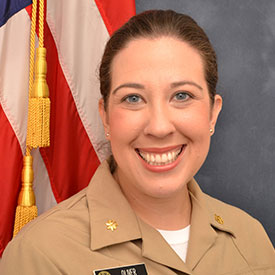 Sara Oliver is an Epidemic Intelligence Service officer with CDC’s Division of Viral Diseases.Sara E. Oliver, M.D., MSPH, has always had an interest in public health. After a medical mission trip to South America following her first year of medical school, Oliver realized she was more intrigued by the population-level health care challenges she encountered.
Sara Oliver is an Epidemic Intelligence Service officer with CDC’s Division of Viral Diseases.Sara E. Oliver, M.D., MSPH, has always had an interest in public health. After a medical mission trip to South America following her first year of medical school, Oliver realized she was more intrigued by the population-level health care challenges she encountered.
That realization eventually led her to apply for the Centers for Disease Control’s (CDC) Epidemic Intelligence Service (EIS), a highly competitive, two-year, postgraduate fellowship program focused on public health issues. Oliver, a 2008 graduate of the School of Medicine, was selected as an EIS officer in 2015.
“I love taking care of patients and the difference you can make in their lives, but I always had a sense that there was the potential to do something on a larger scale,” Oliver says. “Once I learned about EIS and the work that CDC does with regards to public health, I realized the EIS program was an amazing opportunity to participate in front-line public health responses and research as well as have mentorship and training to develop a career in public health.”
Joining the Force
As an EIS officer with CDC’s Division of Viral Diseases, Oliver works on several projects on the front lines of public health. She is working to evaluate HPV vaccine uptake in vulnerable populations and led the investigation into an outbreak of ocular syphilis. “This involves collecting information to evaluate for potential increases in cases and assisting with investigations and public health responses,” Oliver says. “I have had the opportunity to interact with both clinicians and public health workers from across the country, and work with our division to disseminate important public health messages, including scientific publications and messages to social media.”
As part of her job, Oliver has opportunities to travel domestically and internationally to support public health efforts. In addition, she is on call during certain weeks, available for “rapid response” to potential public health emergencies, such as Zika virus.
Before joining the CDC, Oliver completed a pediatric residency at Cincinnati Children’s Hospital Medical Center and a pediatric infectious disease fellowship at UAB. Other members of her EIS class have a variety of educational backgrounds, including physicians in a variety of specialties as well as veterinarians, nurses, and scientists from diverse fields.
A Firm Foundation
The years Oliver spent training at UAB have served her well in her pursuit of a career in public health. While completing her pediatric infectious disease fellowship, Oliver also pursued a Master of Science in Public Health in applied epidemiology. “While in medical school at UAB, I was able to learn great foundational skills regarding medicine and research I still use on a daily basis,” Oliver says. “They helped me develop into a clinician who can think broadly and independently. I also was able to work with incredible researchers who instilled in me a love of asking research questions and then figuring out a way to systematically answer them.”
While working on a summer research project with David Kimberlin, M.D., professor of pediatrics and co-director of the Division of Pediatric Infectious Diseases, Oliver says she first saw the potential for a career in research. And Shannon Ross, M.D., and Suresh Boppana, M.D., helped mold her clinical and research skills during her fellowship. “It was over the entire course of my medical education, seven of the 10 years of it at UAB, that helped me collect all the skills I needed to be where I am today,” she says.
During her time with the Epidemic Intelligence Service, Oliver hopes to gain real-world experience in applied public health science to make an impact on a population level. “This opportunity is invaluable to my overall career goals of continuing work in epidemiologic research with regards to infectious diseases, with a focus on diseases impacting children,” she says.
By Nancy Mann Jackson